CSC/ECE 506 Spring 2011/ch2a mc
Introduction
The Graphical Processing Unit (GPU) is a dedicated, super-threaded, massively data parallel co-processor. Unlike the CPU, GPUs are designed to be highly parallel, have a high computational throughput, and have high memory throughput. CPUs are designed to perform well for single and multi-threaded applications. A number of programming APIs have been introduced to allow programmers to harness the power of the GPU to perform parallel tasks. Two such architectures are OpenCL and Compute Unified Device Architecture (CUDA).
OpenCL
Programming Model
As of version 1.1 of the OpenCL specification[1], the programming model of OpenCL is a hybrid of task parallelism and data parallelism. We will first describe the key concepts of OpenCL.
Platform Model
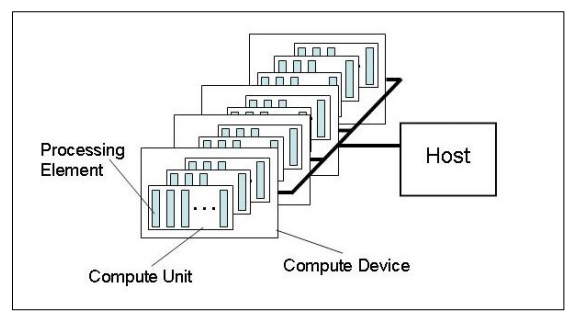
As shown in Figure 1, the platform for running OpenCL programs somewhat resembles a network of computer clusters. The similarity is quite significant, each Compute Device behaves like a cluster, which consists of computers (in the form of Compute Unit - CU), and each Compute Unit can contain multiple Processing Elements (PEs), much like a computer can contain multiple CPUs.
Execution Model
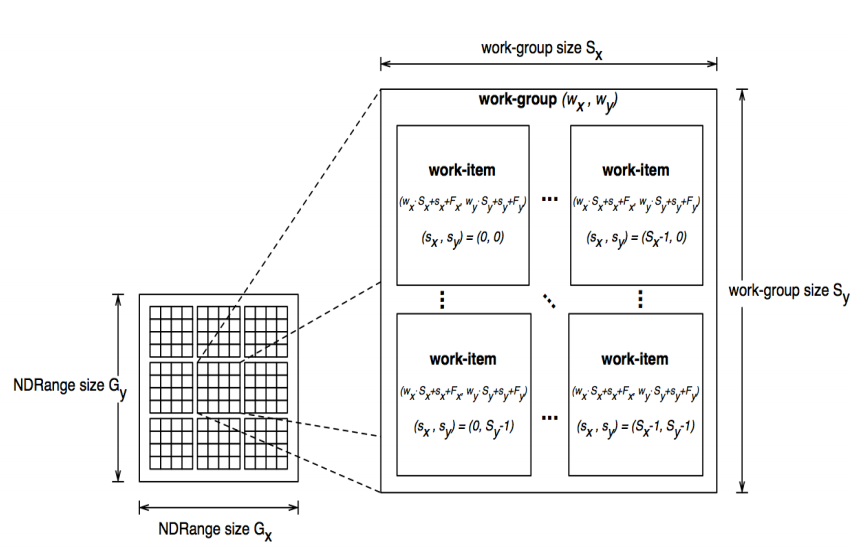
Figure 2 depicts the conceptual model of execution. There is a host program which executes on the host and manages the execution of multiple compute kernels. Each compute kernel can execute in parallel on separate work-items. Related work-items can then be grouped into a work-group. This execution model closely matches the platform model described above, as each PE often executes one kernel, and one work-group is often handled by one CU. In this way, communication overhead is reduced, thus improving performance.
Memory Model
The memory model of OpenCL reflects the design of the platform model and execution model. Specifically, there are four levels of memory, as shown in the table below.
| Memory Regions | Accessible by |
|---|---|
| Global Memory | All work-items in all work-groups |
| Constant Memory | All work-items in all work-groups |
| Local Memory | All work-items in a work-group |
| Private Memory | Private to a work-item |
Programming Model
To take advantage of OpenCL architecture, two programming models can be used. The first one the is data parallel programming model and the other one is the task parallel programming model. In the data parallel programming model, every computer kernel executes the same block of code, but on different data. Therefore, conceptually there is one global program counter for all computer kernels. The programmer can choose to manually partition the kernels into groups, or delegate this task to the OpenCL middleware. Besides the data parallel programming model, the programmer can choose to use the task parallel programming model. In this case, each PE will execute a separate compute kernel, and parallelism is achieved by running multiple kernels on separate work-items.
Implementation
AMD Implementation
The first GPU generation from AMD that supports OpenCL 1.1 is the Radeon HD 5000 series. Latest generations also support OpenCL 1.1, with significantly improved performance due to architectural refinements. The table below summarizes key characteristics of Radeon HD 6000 GPUs.
| Model | Clock rate | Config core | Memory | TDP (W) | Double-precision FP | ||||
|---|---|---|---|---|---|---|---|---|---|
| Core (MHz) | Memory (MHz) | Bandwidth (GB/s) | Bus type | Bus width (bit) | Idle | Max. | |||
| Radeon HD 6450 | 625-750 | 533-800 800-900 | 160:8:4 | 8.5-12.8 25.6-28.8 | DDR3, GDDR5 | 64 | ? | 31 | No |
| Radeon HD 6570 | 650 | 900 1000 | 480:24:8 | 28.8 64 | GDDR3 GDDR5 | 128 | ? | ? | No |
| Radeon HD 6670 | 800 | 1000 | 480:24:8 | 64 | GDDR5 | 128 | ? | 63 | No |
| Radeon HD 6750 | 720:36:16 | up to 73.6 | GDDR5 | 128 | 16 | 86 | No | ||
| Radeon HD 6770 | 800:40:16 | up to 76.8 | GDDR5 | 128 | 18 | 108 | No | ||
| Radeon HD 6850 | 775 | 1000 | 960:48:32 | 128 | GDDR5 | 256 | 19 | 127 | No |
| Radeon HD 6870 | 900 | 1050 | 1120:56:32 | 134.4 | GDDR5 | 256 | 19 | 151 | No |
| Radeon HD 6950 | 800 | 1250 | 1408:88:32 | 160 | GDDR5 | 256 | 20 | 200 | 563 |
| Radeon HD 6970 | 880 | 1375 | 1536:96:32 | 176 | GDDR5 | 256 | 20 | 250 | 675 |
| Radeon HD 6990 | ? | ? | 3072:?:? | ? | GDDR5 | 2x 256 | ? | ~300 | Yes |
As can be seen from Table 1, GPUs can have a wide range of parameters, which often lead to performance differences. The top-of-the-line model like Radeon HD 6970 is equipped with more cores (PE), wider memory bus bandwidth and faster clock rate. As a result, it is much faster than a low-end model with significantly reduced configurations.
According to specification published by AMD[3], Radeon HD GPU organization has significant similarity with OpenCL platform model described above. The similarity can be seen from the figure below, where the DPP array is essentially a group of CUs, local data share is simply a local memory region (in OpenCL terminology),
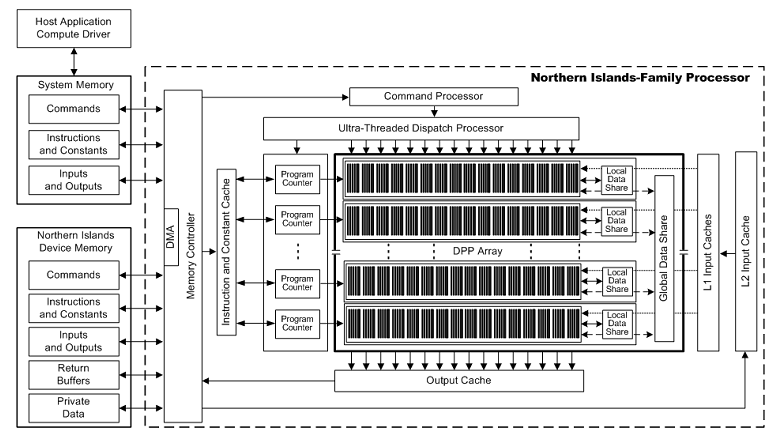
This is by design as the closeness between the conceptual model and the implementation assists in the development process and improves performance.
NVidia Implementation
The first Nvidia GPU generation to support OpenCL 1.1 is GeForce 400 series. Their architecture is shown in the following figure.
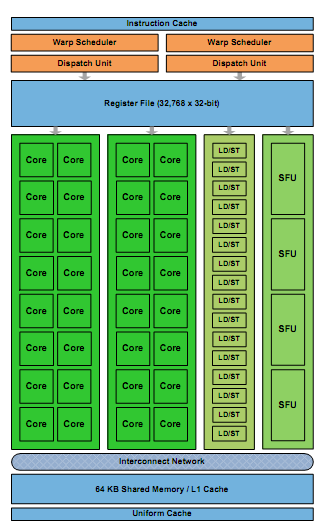
As shown in Figure 4, NVidia's Implementation follows almost the same design, with slightly different variations. Each core is essentially a PE; which are grouped into Streaming Multiprocessor (SM). Cores have access to two level caches and a register file, similar to AMD's design. The differences apparently are in terminology and are not fundamental.
Sample Application
OpenCL applications are mainly implemented in C; a C++ wrapper built on top of C is also available. According to the OpenCL 1.1 specification, the OpenCL C language is based on ISO C99, with extensions designed for parallel computing[1]. The following is sample application to compute a Fast Fourier Transformation (FFT)[5].
// OpenCL code written by Aaftab Munshi // create a compute context with GPU device context = clCreateContextFromType(NULL, CL_DEVICE_TYPE_GPU, NULL, NULL, NULL); // create a command queue queue = clCreateCommandQueue(context, NULL, 0, NULL); // allocate the buffer memory objects memobjs[0] = clCreateBuffer(context, CL_MEM_READ_ONLY | CL_MEM_COPY_HOST_PTR, sizeof(float)*2*num_entries, srcA, NULL); memobjs[1] = clCreateBuffer(context, CL_MEM_READ_WRITE, sizeof(float)*2*num_entries, NULL, NULL); // create the compute program program = clCreateProgramWithSource(context, 1, &fft1D_1024_kernel_src, NULL, NULL); // build the compute program executable clBuildProgram(program, 0, NULL, NULL, NULL, NULL); // create the compute kernel kernel = clCreateKernel(program, "fft1D_1024", NULL); // set the args values clSetKernelArg(kernel, 0, sizeof(cl_mem), (void *)&memobjs[0]); clSetKernelArg(kernel, 1, sizeof(cl_mem), (void *)&memobjs[1]); clSetKernelArg(kernel, 2, sizeof(float)*(local_work_size[0]+1)*16, NULL); clSetKernelArg(kernel, 3, sizeof(float)*(local_work_size[0]+1)*16, NULL); // create N-D range object with work-item dimensions and execute kernel global_work_size[0] = num_entries; local_work_size[0] = 64; clEnqueueNDRangeKernel(queue, kernel, 1, NULL, global_work_size, local_work_size, 0, NULL, NULL);
The compute kernel is specified in the variable fft1D_1024_kernel_src, its source code is provided below:
// This kernel computes FFT of length 1024. The 1024 length FFT is decomposed into
// calls to a radix 16 function, another radix 16 function and then a radix 4 function
__kernel void fft1D_1024 (__global float2 *in, __global float2 *out,
__local float *sMemx, __local float *sMemy) {
int tid = get_local_id(0);
int blockIdx = get_group_id(0) * 1024 + tid;
float2 data[16];
// starting index of data to/from global memory
in = in + blockIdx; out = out + blockIdx;
globalLoads(data, in, 64); // coalesced global reads
fftRadix16Pass(data); // in-place radix-16 pass
twiddleFactorMul(data, tid, 1024, 0);
// local shuffle using local memory
localShuffle(data, sMemx, sMemy, tid, (((tid & 15) * 65) + (tid >> 4)));
fftRadix16Pass(data); // in-place radix-16 pass
twiddleFactorMul(data, tid, 64, 4); // twiddle factor multiplication
localShuffle(data, sMemx, sMemy, tid, (((tid >> 4) * 64) + (tid & 15)));
// four radix-4 function calls
fftRadix4Pass(data); // radix-4 function number 1
fftRadix4Pass(data + 4); // radix-4 function number 2
fftRadix4Pass(data + 8); // radix-4 function number 3
fftRadix4Pass(data + 12); // radix-4 function number 4
// coalesced global writes
globalStores(data, out, 64);
}
As can be seen from the above example, OpenCL C program has a clear control flow. The host program first creates a global share memory area and initializes the environment. It then instructs the driver to compile the compute kernel from OpenCL C source code to machine code specific to the hardware PEs. [3] The compute kernels are then enqueued to run on the compute device. When the results are available the host program will be notified. Developing a compute kernel is a relatively straightforward process. Data are first loaded from global memory to local memory. The kernels will then perform computation on this chunk of data. The result will be written back to global memory.
Compute Unified Device Architecture (CUDA)
CUDA is a proprietary parallel architecture available to modern Nvidia GPUs. CUDA was first introduced with Nvidia's GeForce 8, February 2007[6], series of video cards. This architecture gives programmers access to the GPU's multicore processor for performing math intensive operations. These operations include physics modeling (PhysX), physical modeling, image processing, matrix algebra, etc. These GPUs are specifically design to perform many floating point and integer operations simultaneously. CUDA is capable of handling millions of threads simultaneously with little overhead to manage this large number of threads.
CUDA Architecture
Figure 5 shows the typical arrangement for a GPU multiprocessor. This figure shows the general flow path of data through the GPU. Data flows from the host to the thread execution manager, which spawns and schedules the threads to each stream processor (SP). Each multi-processor, in this figure, contains eight stream processors. Each stream processor has its own memory, texture filter (TF). Each pair of processors has a shared L1 cache. Global memory is a shared memory is shared amongst all the stream processors.
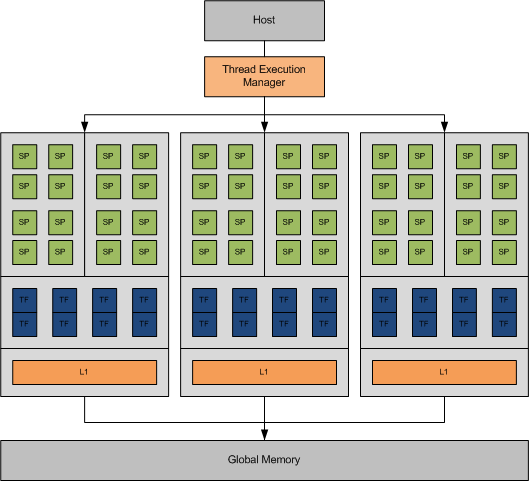
CUDA Threads
In CUDA programming, serial operations are still handled by the host CPU (main processor) while parallelizable kernels are handed off to the GPU for processing. It is important to understand the layout of the CUDA architecture and memory. Figure 6 shows a simplified block diagram of a typical CUDA thread model.
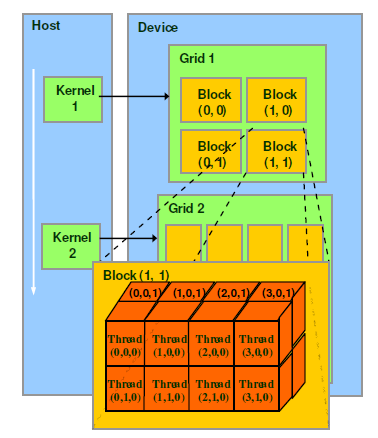
Each kernel is assigned a grid. Each grid contains a number of blocks. Each block contains threads (512 maximum per block).
CUDA Programming
Programming using CUDA is accomplished via language extensions or wrappers. These extensions are available for a number of common programming langauages such as:
Coding using CUDA is fairly straightforward. The listing below[8] shows a simple program that will square each value in a matrix. The code in main() prepares the GPU to execute the kernel by allocating the appropriate amount of memory and also to receive the result from the GPU. The code in the method 'square_array' is the code that is executed on the GPU.
// Sample code taken from http://llpanorama.wordpress.com/2008/05/21/my-first-cuda-program/
// by Dave Vandenbout
#include "stdafx.h"
#include <stdio.h>
#include <cuda.h>
// Kernel that executes on the CUDA device
__global__ void square_array(float *a, int N)
{
int idx = blockIdx.x * blockDim.x + threadIdx.x;
if (idx<N) a[idx] = a[idx] * a[idx];
}
// main routine that executes on the host
int main(void)
{
float *a_h, *a_d; // Pointer to host & device arrays
const int N = 10; // Number of elements in arrays
size_t size = N * sizeof(float);
a_h = (float *)malloc(size); // Allocate array on host
cudaMalloc((void **) &a_d, size); // Allocate array on device
// Initialize host array and copy it to CUDA device
for (int i=0; i<N; i++)
a_h[i] = (float)i;
cudaMemcpy(a_d, a_h, size, cudaMemcpyHostToDevice);
// Do calculation on device:
int block_size = 4;
int n_blocks = N/block_size + (N%block_size == 0 ? 0:1);
square_array <<< n_blocks, block_size >>> (a_d, N);
// Retrieve result from device and store it in host array
cudaMemcpy(a_h, a_d, sizeof(float)*N, cudaMemcpyDeviceToHost);
// Print results
for (int i=0; i<N; i++)
printf("%d %f\n", i, a_h[i]);
// Cleanup
free(a_h);
cudaFree(a_d);
}
The line 'square_array square_array <<< n_blocks, block_size >>> (a_d, N);' is where the main CPU hands off the execution to the GPU. The amount of parallelism utilized in 'square_array' depends on the number of blocks and the block size, which is allocated by the programmer. CUDA will handle the details of the parallel execution for the programmer.
Definitions
- Central Processing Unit (CPU) - this is the main processor of the system where the instructions of a computer program are executed.
- General Purpose Graphical Processing Unit (GPGPU) - a GPU that is designed to allow its use to perform complex calculations. Its purpose is to reduce the number of computations in the main CPU.
- Compute Unified Device Architecture (CUDA) - Nvidia's implementation of parallel computing designed to run on Nvidia hardware only.
- Graphics Processing Unit (GPU) - a dedicated processor designed to reduce the CPU load when rendering a video display. Can also perform general purpose calculations, also known as a GPGPU.
- OpenCL - An open parallel computing architecture that is supported by a number of hardware vendors, including AMD, Nvidia, S3 Graphics, and VIA Technologies.
- PhysX - a proprietary physics computation engine develeped by Ageia. PhysX can run on a dedicated PhysX physics processing unit or a CUDA-enabled GeForce GPU.
- Stream Processor (SP) - a specialized processor that allows limited floating point calculations to be performed without the need to explicitly manage the communication or synchronization between stream processors.
References
- http://www.khronos.org/registry/cl/specs/opencl-1.1.pdf
- http://en.wikipedia.org/wiki/Comparison_of_AMD_graphics_processing_units#Northern_Islands_.28HD_6xxx.29_series
- http://developer.amd.com/gpu/AMDAPPSDK/assets/AMD_HD_6900_Series_Instruction_Set_Architecture.pdf
- http://www.nvidia.com/content/PDF/fermi_white_papers/NVIDIA_Fermi_Compute_Architecture_Whitepaper.pdf
- http://en.wikipedia.org/wiki/Opencl
- http://en.wikipedia.org/wiki/CUDA
- http://courses.engr.illinois.edu/ece498/al
- http://llpanorama.wordpress.com/2008/05/21/my-first-cuda-program